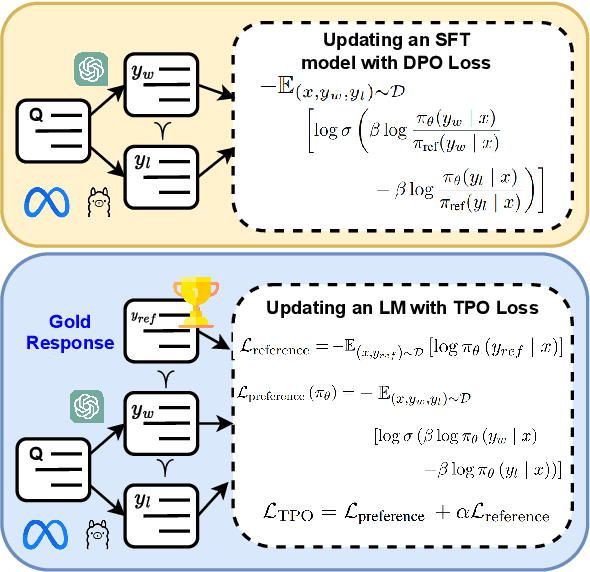Shivanshu Verma
Triple Preference Optimization: Achieving Better Alignment with Less Data in a Single Step Optimization
May 26, 2024



Abstract:Large Language Models (LLMs) perform well across diverse tasks, but aligning them with human demonstrations is challenging. Recently, Reinforcement Learning (RL)-free methods like Direct Preference Optimization (DPO) have emerged, offering improved stability and scalability while retaining competitive performance relative to RL-based methods. However, while RL-free methods deliver satisfactory performance, they require significant data to develop a robust Supervised Fine-Tuned (SFT) model and an additional step to fine-tune this model on a preference dataset, which constrains their utility and scalability. In this paper, we introduce Triple Preference Optimization (TPO), a new preference learning method designed to align an LLM with three preferences without requiring a separate SFT step and using considerably less data. Through a combination of practical experiments and theoretical analysis, we show the efficacy of TPO as a single-step alignment strategy. Specifically, we fine-tuned the Phi-2 (2.7B) and Mistral (7B) models using TPO directly on the UltraFeedback dataset, achieving superior results compared to models aligned through other methods such as SFT, DPO, KTO, IPO, CPO, and ORPO. Moreover, the performance of TPO without the SFT component led to notable improvements in the MT-Bench score, with increases of +1.27 and +0.63 over SFT and DPO, respectively. Additionally, TPO showed higher average accuracy, surpassing DPO and SFT by 4.2% and 4.97% on the Open LLM Leaderboard benchmarks. Our code is publicly available at https://github.com/sahsaeedi/triple-preference-optimization .
Insights into Alignment: Evaluating DPO and its Variants Across Multiple Tasks
Apr 23, 2024



Abstract:Large Language Models (LLMs) have demonstrated remarkable performance across a spectrum of tasks. Recently, Direct Preference Optimization (DPO) has emerged as an RL-free approach to optimize the policy model on human preferences. However, several limitations hinder the widespread adoption of this method. To address these shortcomings, various versions of DPO have been introduced. Yet, a comprehensive evaluation of these variants across diverse tasks is still lacking. In this study, we aim to bridge this gap by investigating the performance of alignment methods across three distinct scenarios: (1) keeping the Supervised Fine-Tuning (SFT) part, (2) skipping the SFT part, and (3) skipping the SFT part and utilizing an instruction-tuned model. Furthermore, we explore the impact of different training sizes on their performance. Our evaluation spans a range of tasks including dialogue systems, reasoning, mathematical problem-solving, question answering, truthfulness, and multi-task understanding, encompassing 13 benchmarks such as MT-Bench, Big Bench, and Open LLM Leaderboard. Key observations reveal that alignment methods achieve optimal performance with smaller training data subsets, exhibit limited effectiveness in reasoning tasks yet significantly impact mathematical problem-solving, and employing an instruction-tuned model notably influences truthfulness. We anticipate that our findings will catalyze further research aimed at developing more robust models to address alignment challenges.
 Add to Chrome
Add to Chrome Add to Firefox
Add to Firefox Add to Edge
Add to Edge